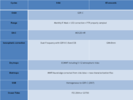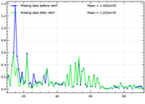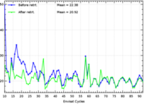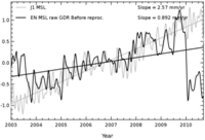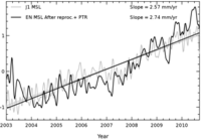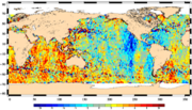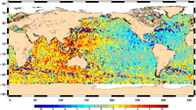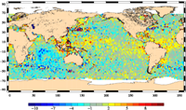Envisat reprocessing
For the first time, this year, a whole mission reprocessing occurred for Envisat altimetric data set. During one year, all cycles from 9 to 92 (September 2010) were reprocessed into a homogeneous standard (so called V2.1 version) and added to the current production time series. Furthermore, cycles 6 to 9 were processed for the first time, though giving access to 3 additional month of data dated in 2002 (complete report).
To many points, these reprocessed data are better than the original GDR time series:
In terms of available and valid data,
the coverage is better, notably thanks to a better availability of MWR at the beginning of the mission
In terms of performance at cross-overs,
the quality is also improved : the annual signal and average of Mean SSH is decreased, as well as the standard deviation. The gain was estimated to around 4.8cm2 with some maximums of 8cm2. This is very significant for GDR raw data set!
In terms of Global Mean Sea Level trend of raw GDR
The homogenization of processing increases our confidence in the data notably for long term drift applications such as Mean Sea Level trend computation. A remaining error concerning the sign of an instrumental correction (PTR) was identified in the GDR reprocessed data. An external input enables to correct for this anomaly. It will be made available to users soon. For the time being, it is already taken into account on the MSL Aviso web site
Envisat and Jason-1 MSL using the GDR before reprocessing (left)
and after reprocessing with PTR well sampled but with correct sign (right).
Credits CLS/Esa/Cnes
In terms of regional Mean Sea Level,
Map of Jason-1 minus Envisat trends differences from November 2003 to September 2009
before reprocessing (left), after reprocessing (middle), and with GDR-D orbit (right).
Credits CLS/Esa/Cnes
Note that some remaining issues were also well identified:
they concern the radiometer wet tropospheric content (an unexpected behavior of the new field was identified, understood and shown to be possibly corrected) and the SSB, because of its iterative processing wich should be solved by new SSB model already planned for 2012 (using the new reprocessed standards).
Further information:
- for a complete report: Envisat RA2/MWR reprocessing impact on ocean data (March 2012, 14 Mo)
- Systematic Validation activties
- Mean Sea Level rise
